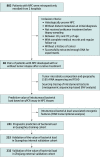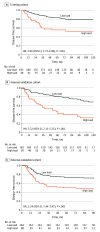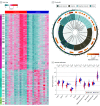Association of Intratumoral Microbiota With Prognosis in Patients With Nasopharyngeal Carcinoma From 2 Hospitals in China
- PMID: 35834269
- PMCID: PMC9284409
- DOI: 10.1001/jamaoncol.2022.2810
Association of Intratumoral Microbiota With Prognosis in Patients With Nasopharyngeal Carcinoma From 2 Hospitals in China
Abstract
Importance: Microbiota-tumor interactions have qualified microbiota as a promising prognostic biomarker in various types of cancers. Although the nasopharynx acts as a crucial niche of the upper respiratory tract microbiome, whether the intratumoral microbiota exists and its clinical significance in nasopharyngeal carcinoma (NPC) remain uncertain.
Objective: To evaluate the clinical significance of intratumoral microbiota for individual prognostication in patients with NPC.
Design, setting, and participants: This retrospective cohort study included NPC biopsy samples from 2 hospitals: Sun Yat-sen University Cancer Center (Guangzhou, China) and Zhejiang Cancer Hospital (Hangzhou, China) between January 2004 and November 2016, with follow-up through November 2020. A total of 802 patients were included according to the following criteria: with histologically proven NPC, without distant metastasis at initial diagnosis, had not received antitumor treatment before biopsy sampling, aged between 18 and 70 years, with complete medical records and regular follow-up, without a history of cancer, and successfully extracted enough DNA for experiments.
Main outcomes and measures: The primary end point was disease-free survival, and the secondary end points included distant metastasis-free survival and overall survival. To assess the existence and load of intratumoral microbiota in 96 patients with NPC with or without tumor relapse, 16S rRNA sequencing and quantitative polymerase chain reaction were used. The associations between intratumoral bacterial load and clinical outcome were evaluated in 241 fresh-frozen NPC samples (training cohort) and validated in paraffin-embedded NPC samples of internal (n = 233) and external (n = 232) validation cohorts. Metagenomic and transcriptome analyses were performed to ascertain the origin and underlying mechanism of intratumoral bacteria.
Results: A total of 802 patients with NPC (mean [SD] age, 46.2 [10.6] years; 594 [74.1%] male) were enrolled. Microbiota presented within NPC tumor tissues, among which Corynebacterium and Staphylococcus predominated. Patients with a high bacterial load in the training cohort had inferior rates of disease-free survival (hazard ratio [HR], 2.90; 95% CI, 1.72-4.90; P < .001), distant metastasis-free survival (HR, 3.18; 95% CI, 1.58-6.39; P < .001), and overall survival (HR, 3.41; 95% CI, 1.90-6.11, P < .001) than those with a low bacterial load, a finding that was validated by the internal and external validation cohorts. Single-nucleotide variant analysis revealed that the nasopharyngeal microbiota was the main origin of NPC intratumoral bacteria. Transcriptome and digital pathology analyses demonstrated that a higher intratumoral bacterial load was negatively associated with T-lymphocyte infiltration.
Conclusions and relevance: Intratumoral bacterial load was a robust prognostic tool for patients with NPC in this cohort study, indicating potential guidance for treatment decisions in patients at different levels of risk of malignant progression.
Conflict of interest statement
Figures




References
Publication types
MeSH terms
Substances
LinkOut - more resources
Full Text Sources
Other Literature Sources
Molecular Biology Databases

